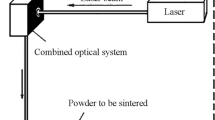This article presents the results of the analysis of the patent situation in the field of 3D printing technologies with metals and materials based on them and the prospects for their development. In the development of the life cycle of patenting laser additive technologies in Russia in 2000–2020, three main stages can be distinguished, namely, Stage I for 2000–2008, Stage II for 2009–2015, and Stage III for 2016–2020. In terms of the applicability of patent solutions in the field of laser additive technologies, the most developed industries are the mechanical engineering and metallurgical industries. The leaders of patenting in the Russian Federation territory are BASF and Siemens (Germany) and Airbus Operation (France). The leading countries where applicants strive to obtain patents are the USA, Russia, China, Japan, and the countries of the European Union. Three main directions can be distinguished among the main trends in the development of laser additive technologies: development of basic cultivation technologies (development of effective technological modes) of products and technologies of combined processing (e.g., deformation, thermal, and thermal–deformation); development of devices and equipment for additive manufacturing, including special equipment that ensures high-quality geometric parameters and improves the performance properties of the product during the production process; and development and creation of new powder materials and their compositions with a given granulometric composition and technologies for their production.






Similar content being viewed by others
References
M. Leturia, M. Benali, S. Lagarde, I. Ronga, and K. Saleh, “Characterization of flow properties of cohesive powders: A comparative study of traditional and new testing methods,” Powder Technol., 253, 406–423 (2014).
M. A. Zlenko, A. A. Popovich, and I. N. Mutylina, Additive Technologies in Mechanical Engineering [in Russian], St. Petersburg, Izdatel’stvo Sankt-Peterburgskogo Gos. Politekh. Univ. (2013).
A. Ya. Travyanov, A. V. Dub, P. V. Petrovsky, and V. V. Cheverikin, “Investigation of mechanical properties of cellular structures made of corrosion-resistant steel 03X16H15M3 depending on the parameters of the unit cell,” Chern. Metal., No. 10, 59–63 (2018).
M. A. Dremukhin and V. N. Nagovitsin, “The use of additive technologies in mechanical engineering for the manufacture of shapegenerating moulding tools,” Kosmich. Apparaty Tekhnol., 6, No. 1 (39), 21–28 (2022).
A. A. Popovich, “Additive technologies as a new method to create promising functional materials,” MiTOM, No. 1 (775), 19–25 (2020).
Yu. V. Denisova, “Additive technologies in construction,” Stroit. Mat. Izdel., 1, No. 3, 33–42 (2018).
I. E. Malov, “Additive technologies in the production of molds,” Svarochn. Proizvod., No. 5, 44–48 (2021).
A. P. Preobrazhensky and N. M. Tokareva, “Additive technologies: history, methods, materials,” Vestnik Voronezh. Instit. Vysokikh Tekhnol., No. 1 (24), 75–77 (2018).
V. V. Vasiltsov, A. V. Bogdanov, A. G. Grigoryants, and K. I. Makarenko, “Additive laser technologies for sintering metal powders for industrial products,” Svarochn. Proizvod., No. 1, 35–43 (2021).
V. V. Somonov, Study of Patent Activity in the Field of Laser Additive Technologies for Metal Processing in the Russian Federation, Proceedings of the IX Congress of Young Scientists, St. Petersburg, Izdate’stvo Univ. ITMO, 2, 227–232 (2021).
A. A. Dektyarev, V. N. Morozov, and A. Ya. Yafasov, “Additive technologies in shipbuilding: trends and legal regulation,” Morsk. Intellektual. Tekhnol., No. 4-4 (46), 38–49 (2019).
S. Yu. Bogacheva, Comparative Analysis of Powder Bed Fusion and Directed Energy Deposition Technologies, Obrazovatel’naya Initsiativa kak Klyuchevoy Faktor Razvitiya Sfery Znaniy, Kazan, SitIvent, 293–297 (2019).
A. G. Kolmakov, A. Yu. Ivannikov, M. A. Kaplan, A. A. Kirsankin, and M. A. Sevostyanov, “Corrosion-resistant steels in additive manufacturing,” Izv. Vyssh. Ucheb. Zav. Chern. Metallurg., 64, No. 9, 619–650 (2021).
V. G. Shalamov, D. A. Saveliev, and S. D. Smetanin, “Obtaining powder materials by rotary turning,” Vestnik Mashinostr., No. 11, 56–58 (2012).
I. V. Romanov and R. N. Zadorozhny, “Obtaining metal powder materials for additive technologies,” Tekhnich. Servis Mashin, No. 2 (147), 155–164 (2022).
A. G. Ermilov, V. V. Safonov, Yu. P. Bashurov, and A. V. Kulifeev, “Production of composite powder materials by chemical vapor deposition,” Tsvetn. Metal., No. 6, 51–66 (2002).
Author information
Authors and Affiliations
Corresponding author
Additional information
Translated from Metallurg, Vol. 66, No. 10, pp. 87–92, October, 2022. Russian DOI: https://doi.org/10.52351/00260827_2022_10_87.
Rights and permissions
Springer Nature or its licensor (e.g. a society or other partner) holds exclusive rights to this article under a publishing agreement with the author(s) or other rightsholder(s); author self-archiving of the accepted manuscript version of this article is solely governed by the terms of such publishing agreement and applicable law.
About this article
Cite this article
Sheksheev, M.A., Polyakova, M.A., Korchunov, A.G. et al. Analysis of Trends in the Development of 3D Printing Technologies with Metal-Based Powder Materials. Metallurgist 66, 1282–1289 (2023). https://doi.org/10.1007/s11015-023-01442-2
Received:
Revised:
Accepted:
Published:
Issue Date:
DOI: https://doi.org/10.1007/s11015-023-01442-2




